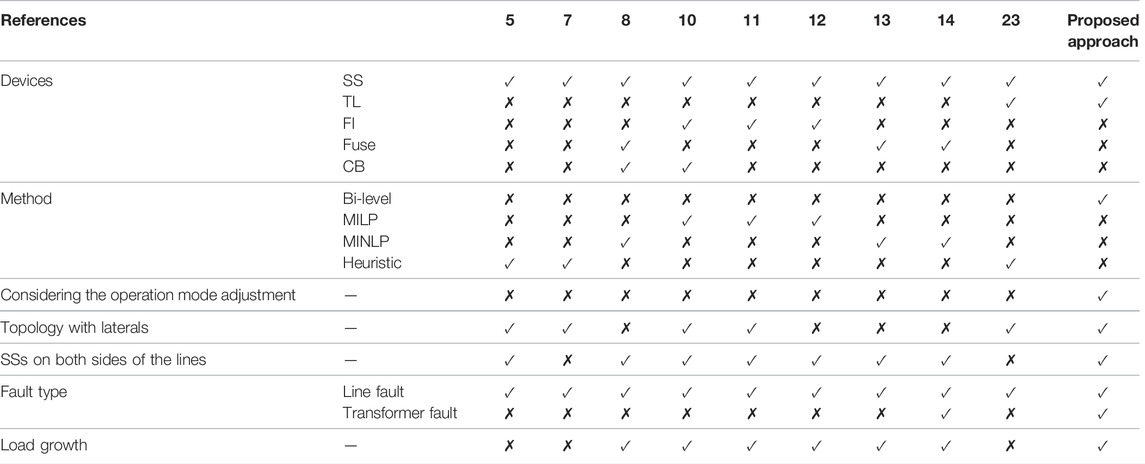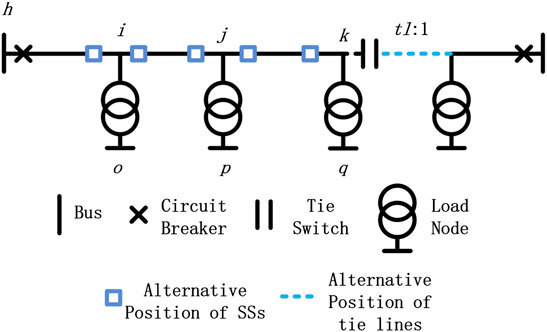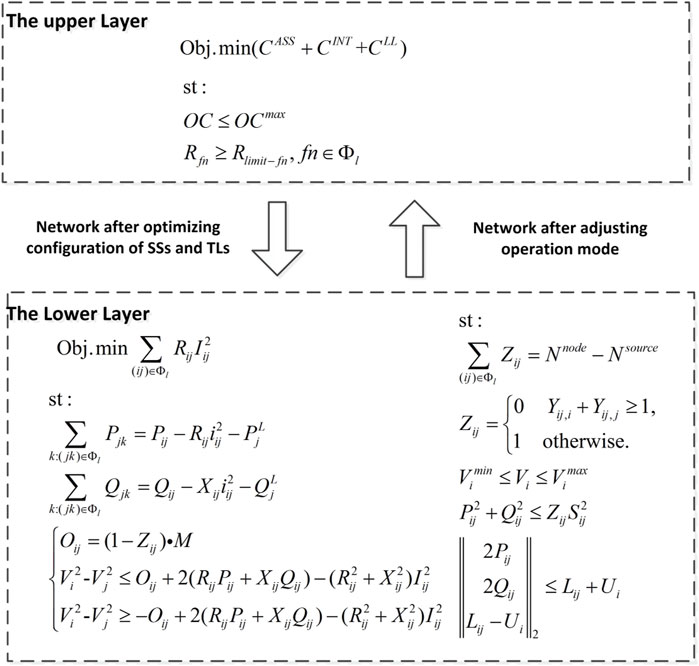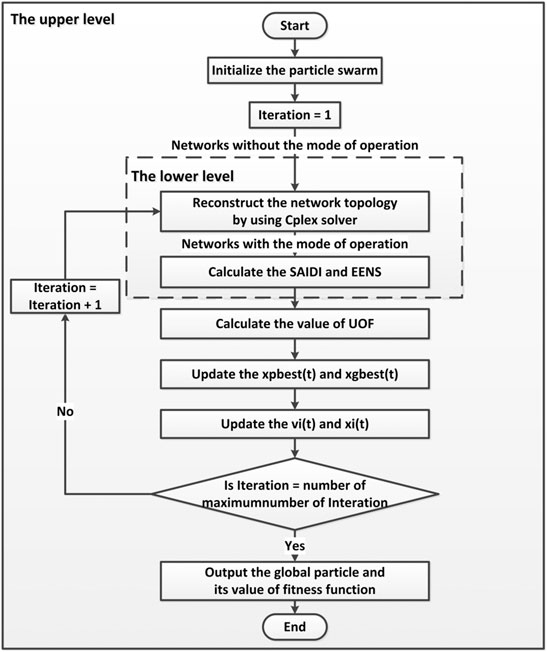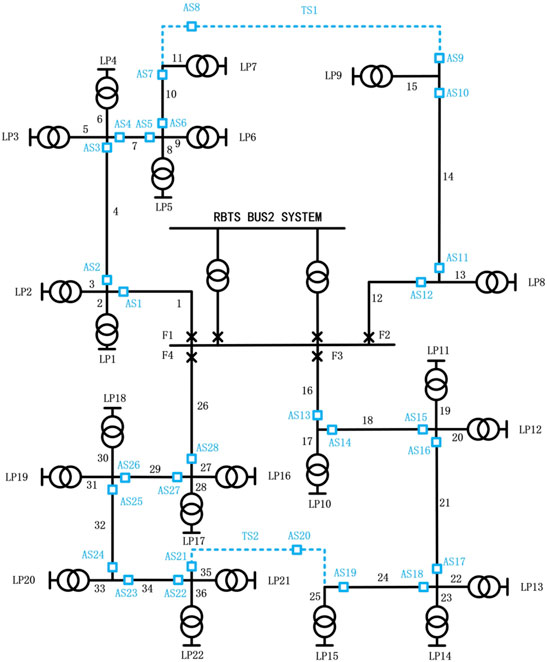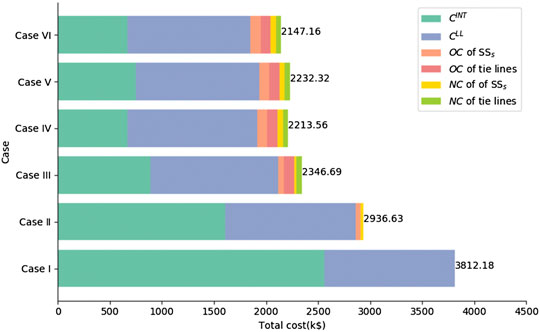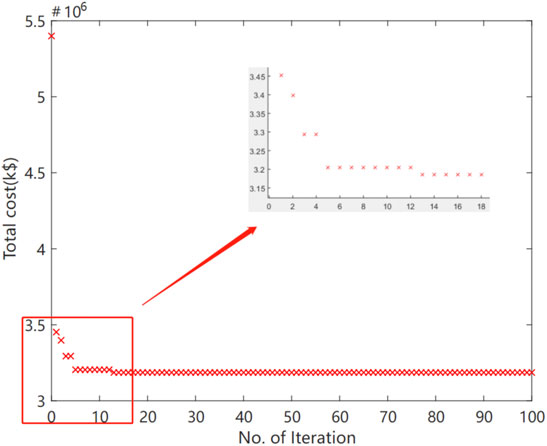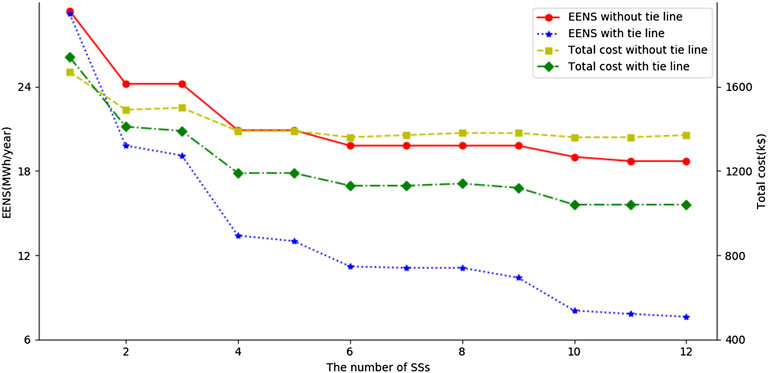- 1Planning Research of Guangdong Power Grid Co., Ltd., Guangzhou, China
- 2School of Automation, Guangdong University of Technology, Guangzhou, China
- 3Department of Electronic and Electrical Engineering, Brunel University London, London, United Kingdom
Distribution utilities can flexibly control distribution networks by allocating the automatic and remotely controlled sectionalizing switches (SSs), which work with tie lines (TLs) to speed up fault management and are alternative devices for distribution operation mode adjustment. Hence, the SSs and the TLs play an important role in distribution networks. In order to improve the reliability of power supply and achieve economic distribution network operation, this paper proposes a bi-level SSs and TLs planning model, which considers distribution operation mode adjustment to optimize the allocation of SSs and TLs. The upper level of the proposed model aims at minimizing the sum of the total investment cost, the customer interruption loss cost, and the line loss cost. The upper level identifies the number and location of the SSs and the TLs. With the planning scheme obtained from the upper level, the lower level of the model adjusts the distribution operation mode to minimize the distribution line loss. In addition, binary particle swarm optimization (BPSO) is used because it has stable convergence and effectively explores the search space. A second-order cone programming (SOCP) is employed to reduce the complexity of the model and improve the solving process by linearizing the reconstruction calculation of the distribution network. Finally, simulation studies were conducted on bus 2 and bus 4 of the RBTS standard test system to assess the feasibility of the proposed model. The stability and effectiveness of the model are verified through various comparisons.
1 Introduction
Power supply plays an increasingly important role in human life and social production, even short-term power interruptions lead to intolerable results. On one hand, it is necessary for power companies to enhance the reliability of power supply and ensure a higher level of customer satisfaction (Fumagalli et al., 2007). On the other hand, distribution operators seek to meet energy demands at the lowest cost when planning and operating their networks (Velasquez et al., 2016). Thus, it is critical to balance the investment, planning, and operation of the distribution networks.
Studies have suggested that approximately 70% of customer outages are caused by the failures of medium-voltage distribution networks (De et al., 2014), and the allocation of sectionalizing switches (SSs) and tie lines (TLs) is regarded as an effective means to improve reliability. With a fault located, the faulted area is isolated using the SSs so that non-faulted areas can be restored as fast as possible. If there is a line without any TLs, SSs just isolate the faulted area and restore the power supply for the upstream load. Otherwise, SSs can also transfer the downstream load with tie switches.
The literature review shows that some heuristic algorithms, such as the simulated annealing algorithm (Billinton and Jonnavithula, 1996), the ant colony algorithm (Falaghi et al., 2008a), the particle swarm optimization algorithm (Bezerra et al., 2014), and the differential evolution algorithm (Ray et al., 2016), have been widely used to obtain the optimal position and number of switches. But these studies only focus on the optimal placement of single types of switches. Considering the cooperation between different types of switches in the fault management process, two novel reliability evaluation algorithms were proposed in Heidari et al. (2016) and Li et al. (2020a) to help determine the optimal locations of SSs and circuit breakers (CBs). The coordinated planning of SSs and fault indicators (FIs) were developed in Falaghi et al. (2008b), Popovic et al. (2017), and Li et al. (2020b) to balance the reliability of power supply and the relevant costs. Taking different users’ economic losses into account, Heidari et al. (2017) and Gholizadeh et al. (2022) presented the new mixed-integer nonlinear programming (MINLP) formulation to determine the allocation of SSs and fuses. A mixed-integer convex formulation and mixed-integer linear programming (MILP) are extended in a study by Heidari et al. (2014) and Lei et al. (2017), respectively, in order to enhance the solution speed and robustness. Meanwhile, the optimal quantity and locations of SSs can be determined by different planning objectives, e.g., minimizing the customer interruption cost, maximizing power supply reliability index, and maximizing restorable loads. Among them, the customer interruption cost is one of the most popular objectives since it links the power supply reliability with the investment economy. As an important part of expansion planning, the placement of TLs has also attracted the research of many scholars. Miranda et al. (1994), Munoz-Delgado et al. (2017), Jooshaki et al. (2019), and Lin et al. (2019) established the expansion planning models for distribution networks, which determined the line corridor and strictly followed the N-1 criterion. In order to minimize the energy loss and energy not supplied (EENS) after an outage, a new method has been adopted to optimize the TLs and the distributed power sources (DGs) simultaneously (Shojaei et al., 2020). However, few studies take the role of TLs in SSs placement into account. Although Sahoo et al. (2012) tried to develop an optimization model for SSs and TLs, it ignored the relationship between SSs and TLs in fault management; the model was only a two-step optimization model.
The typical implementation of SSs and TLs is carried out in a sequential manner, configuring SSs followed by TLs or configuring TL before SSs. With configuring SSs followed by TLs, the role of the SSs have obviously changed following the change in the distribution network, which causes doubtful optimality of SSs. With configuring TLs before SSs, few SSs will be installed after the configuration of TLs if the funds are insufficient, which will fail to effectively improve the reliability and result in a waste of funds. Accordingly, coordinated planning of SSs and TLs that can overcome the above shortcomings and improving the placement of SSs and TLs will be of great importance for a balance between investment and reliability.
Moreover, the configuration of SSs and TLs can provide the equipment basis for the distribution network reconfiguration (e.g., operation mode adjustment). The reconfiguration adjusts the topology of the distribution network during operation by controlling the opening and closing states of SSs and tie switches (Karimi et al., 2021), achieving the optimal operation mode. The optimal objective function of the distribution network is closely related to the objective function of distribution network reconstruction. Hsu et al. (1993), Skoonpong and Sirisumrannukul (2008), and Wang et al. (2021) established distribution, static reconfiguration models, with minimum network losses, balanced load, and maximum reliability as the optimization goals. For the purpose of minimizing the sum of active power, load balance index, and maximum node voltage deviation, Chen et al. (2020) employed the gray target decision-making strategy to select the best problem in the process of solving multi-objective problems. In order to balance the wind energy permeability and voltage stability, Zhong et al. (2020) used the ranking preference technique with the ideal solution similarity to determine the optimal solution on the basis of obtaining the Pareto front.
In order to balance the planning and operation of distribution networks and the balance between the reliability and the economy, the SSs planning can be broadly divided into two sub-problems: optimal allocation of the SSs and the TLs to improve reliability, optimal operation of distribution networks to reduce network losses. When planning different types of content, bi-level models are more effective to obtain a relatively better solution for distribution planning (Sannigrahi et al., 2019). Zhang et al. (2019) and Du et al. (2019) built the bi-level expansion planning methods for active distribution networks by considering the effect of dynamic reconfiguration on the planning of the DGs and the energy storing system (ESS). To solve the operation and energy optimization problems of multi-microgrid power distribution systems, a novel bi-level model was developed (Xu et al., 2021), in which the upper-level model ensured the stability of the voltage while the lower-level model achieved the ultimate goal of minimizing operating costs.
Since bi-level models have become increasingly popular in solving power system problems, their application in the field of SSs and TLs planning with multiple factors needs to be developed. This motivates the authors to develop a bi-level planning model, in which the number and location of SSs and TLs are found in the upper-level planning model, whereas in the lower-level planning model, distribution network reconfiguration is evaluated to find the optimal operation mode. Table 1 compares the proposed planning model with those in the literature. The main contributions of this paper are summarized below.
1) A bi-level planning model considering distribution operation mode adjustment is proposed. This model is compatible with the decision-making process of coordinated planning of SSs and TLs and operation mode adjustment, optimizing the objectives of both parties simultaneously.
2) This paper fully considers the influence of operation mode adjustment and solves the problem of quantifying and modeling the cooperative relationship between SSs and TLs. The model can provide references for the allocation of SSs and TLs, locating SSs and TLs for reliability and economic benefit.
The rest of this paper is organized as follows. Section 2 describes the proposed bi-level model. The solution of bi-level planning model is given in Section 3, and the case studies are presented in Section 4. Finally, this paper is concluded in Section 5.
2 Bi-Level Model
The installation of SSs and TLs plays an important role in reducing EENS and improving the power supply reliability. The adjustment of the operation mode with the minimum line loss as the objective function can effectively reduce the line loss of the distribution network. The specific implementation of these measures is closely related to the distribution network grid and load division. The installation of SSs, the configuration of TLs, and the operation mode adjustment are put into effect step by step in the traditional distribution network planning. So far, little coordination optimization of SSs and TLs has been performed, and operating mode adjustments have rarely been considered along with SSs optimization. However, these three measures can be implemented together to achieve better economic benefits. Although the installation of SSs and TLs will increase equipment costs, it can decrease the cost of customer interruption loss by reducing the EENS. The adjustment of the operation mode with minimum line loss as the objective function will affect both the line loss cost and the investment income of installed SSs. Therefore, this paper proposes a bi-level programming model. At the upper level, a coordinated planning scheme for SSs and TLs is obtained by optimizing the installation quantity and location of SSs and TLs. At the lower level, the line losses of distribution are minimized by shifting the operation mode. Then, the upper level receives the adjusted distribution network topology from the lower level and calculates the objective function. Without TLs, the operation mode adjustment cannot be carried out.
2.1 Upper-Level Model
2.1.1 Objective Function at Upper Level
As mentioned earlier, the upper level is designed to model the SSs and TLs planning problems. As shown in Eq. 1, the objective function consists of three main terms: 1) total investment costs, 2) customer interruption loss cost, and 3) line loss cost.
The first term models the purchase cost of SSs and TLs from equipment suppliers, installation cost, and operation and maintenance cost. Among them, the first two are one-off costs as shown in Eq. 2, while the operation and maintenance cost is a non-one-off costs that is adopted (Wang et al., 2021). Therefore, interest and inflation rates are included to calculate the present value of SSs operation and maintenance costs because the life cycle of SSs can last several years. The present value of operation and maintenance costs needs to be incorporated into the objective function, which is shown in Eq. 3. The one-off cost and non-one-off cost of SSs and TLs are given in Eq. 4. The one-off cost is determined by the quantity of equipment. For detailed parameter and variable definitions, please refer to the nomenclature.
In Eqs 2, 3,
The second term of Eq. 1, customer interruption cost, is defined by Eq. 7 where the average failure rate of network components, the customer outage duration, the customer outage unit cost, and the load increment ratio are taken into account. The average failure rate of the network components and the customer outage duration is determined by the type of failure. Two types of faults are considered in this study, namely line fault and transformer fault. In this paper,
where
The third term of Eq. 1 represents the line loss of the distribution network, which is related to the open-loop location of the distribution network during operation. In this paper, the reconstruction of the distribution network is developed in the lower-level model, and Eq. 9 is used to calculate the line loss.
2.1.2 Constraints at Upper Level
There is a cap on the total annual investment cost of the power company. The purpose of distribution network planning is not only for economic optimization but also to meet certain reliability standards to ensure reliable electricity consumption. Therefore, the constraints for the current study are defined by Eqs 10, 11, restraining the maximum available one-off cost and minimum limit reliability, respectively.
2.2 Lower-Level Model
2.2.1 Objective Function at Lower Level
An optimal distribution network operation is determined at the lower level by minimizing the active power loss, as represented in Eq. 12.
If expressed in the form of branch current
2.2.2 Constraints at Lower Level
1) Radial Topology Constraints
In order to reduce the difficulty of relay protection and limit the short-circuit current, the distribution network generally operates radially, which means there is no loop in the network. The radial network can be abstracted as a tree structure in graph theory. Each feeder can be regarded as a tree, whose root node, node, and branch correspond to the root, the node, and the side of the tree, respectively. At the same time, the total number of sides must be equal to the number of nodes minus the number of roots, which is expressed as Eq. 15.
2) Voltage Constraint
The node voltage should be constrained in a reasonable range when the distribution network operates properly, as shown in Eq. 19.
3) Branch Capacity Constraint
Each feeder has a certain transmission capacity determined by the wire diameter. If the actual transmission power is too large, the heat generation of the wire will rise sharply, increasing line loss and damaging the distribution line. The capacity of the line can be described by the square limit of the apparent power
4) DistFlow branch power flow constraint
According to Kirchhoff’s law, the input power is numerically equal to the output power of the node, as shown in Eqs 21 and 22.
However, for network reconfiguration, the DistFlow branch power flower constraint is not perfect, and there are still two problems to be solved.
A Zero-input node
Zero-input node refers to a node that has no net outflow or net input power, where
In Eqs 24 and 25, since
B Impact of branch disconnection
If branch
3 Solution Method
Mathematically, the proposed programming model is a bi-level nonlinear and non-convex programming problem in which two objectives (UOF, LOF), should be minimized simultaneously. Namely, the upper level tries to minimize the total cost, while the lower level seeks to minimize distribution line losses. In the upper level, the decision variables are the quantity and location of SSs and TLs, which can be represented by binary variables. The upper-level model can be viewed as a binary optimization problem. The particle swarm optimization (PSO) algorithm was originally developed for solving continuous-variable problems, this paper adopts the binary particle swarm optimization (BPSO) algorithm because it was considered to be the most excellent binary search method (Nguyen et al., 2019; Lee et al., 2022). For some given upper secondary variables, i.e., (EENS, and line loss), they can only be obtained by solving the LOF. The lower-level model problem is a distribution network reconfiguration problem. Compared with the intelligent optimization algorithm, the second-order cone programming method has stronger robustness and faster solution speed (Farivar and Low, 2013; Li et al., 2019). Thus, a mixed-integer second-order cone programming (MISOCP)-embedded BPSO is used to solve the proposed DNP problem. Two different optimization procedures are introduced to specifically solve these two problems.
3.1 BPSO Algorithm
To find the optimal solution to the problem at the upper level, a number of particles are employed. The movement of particles toward finding the optimal solution is guided by the knowledge of individuals and other particles. The velocity of a particle at any moment is determined by its velocity and position at the previous moment and the local and global optimal particle at the current moment (Fernandez-Martinez and Garcia-Gonzalo, 2011), as shown in Eq. 27.
where
Depending on the velocity of the particle, a sigmoid function Eq. 28 is employed to map the velocity to the interval [0,1], which is the probability that the particle will take a value of 1 in the next step.
Each element in the position vector takes only binary values (i.e., 1 or 0). At each iteration, the elements of the position vector are updated according to Eq. 29.
3.2 SOCP
Since the lower-level model is non-convex programming (NP), the second-order cone relaxation technique is introduced to transform the model into a mixed-integer second-order cone programming (MISOCP) model. Two new optimization variables
Equations 30 and 31 are introduced as new constraints in the lower-level model with original variables replaced by new ones. For the non-convex form in Eq. 32, under the condition that the objective function is a strictly increasing function of
Similarly, Eq. 32 is transformed into a standard second-order conical equation.
Next, Cplex solver is introduced to deal with the MISOCP problem, which is a commercial solver and matches the appropriate algorithm with different problems.
3.3 Solution Process
The detailed framework of the proposed bi-level model is shown in Figure 2. The complete solution process is presented as follows and the flow chart is shown in Figure 3.
Step 1: Initialize the particle swarm based on the alternative locations of SSs and TLs.
Step 2: Transmit the network topology corresponding to the particle to the lower level.
Step 3: Reconstruct the network by using Cplex solver.
Step 4: Calculate the system reliability indexes and transmit these indexes back to the upper level.
Step 5: Calculate the value of the objective function.
Step 6: Update the local and global optimal particles.
Step 7: Update the velocities and positions of the particle swarm.
Step 8: If the iteration is over, output the global particle and its value of fitness function. Otherwise, return to Step 3.
4 Numerical Examples
The proposed bi-level model is applied to bus 2 and bus 4 of the modified Roy Billinton Test System (RBTS). In this section, the network data of the test system and other details of the simulations are provided thoroughly for the sake of reproducibility. Then, six case studies are conducted, and the results are comprehensively discussed. The proposed method for the SSs and TLs optimized planning is developed in MATLAB version R2018b and the simulations are carried out on a computer with Intel(R) Core (TM) i5-8400 CPU @ 2.8 GHz 2.81 GHz Processor and 8 GB of RAM.
4.1 Test Network and Simulation Assumptions
The bus 2 consists of 4 feeders, 36 feeder sections, and 22 load nodes, as represented in Figure 4. Also, 2 alternative TLs and a total of 28 alternative locations for the SSs are taken into account. Similarly, bus 4 is made up of 7 feeders, 67 feeder sections, 38 load nodes, 58 alternate positions of SSs, and 5 alternate positions of TLs, which was shown in Figure 5. The required data regarding reliability parameters, electrical parameters, and load data are derived from Billinton and Jonnavithula (1996). Table 2 represents the data for load nodes of bus 2. Table 3 presents the ratio between the load of the modified bus 4 in this paper and the load in Billinton and Jonnavithula (1996). The line length and the wire types of bus 2 are provided in Tables 4, 5, respectively.
In the implemented simulations, all the SSs are assumed to be automatic and the switching duration of SSs is 1 min. The economic data for the alternative SSs and potential TLs are presented in Table 6. The investment recovery rate is set to 5%. The electricity average price and electricity price conversion multiples,
7In the lower-level model, the maximum number of iterations is 100, and the size of the particle population is 3,000. The value of particles' maximum velocity, the inertia weight, and the SSs configuration probability are 1.2, 0.9, and 0.15, respectively. The factors of learning and individual learning are 2.
4.2 Numerical Results of the Comparative Cases
Six cases are simulated to demonstrate the effectiveness of the proposed model as well as to show how considered operation mode adjustment provides advantages for the system.
Case I: This case provides information regarding the original network not installed with any SSs and TLs, which is a comparison benchmark to show the effectiveness of equipment deployment.
Case II: In this case, TLs are not allowed to be installed.
Case III: In this case, the TLs are installed after installing SSs.
Case IV : The upper-level model is executed independently without the lower-level model in this case.
Case V: Network reconstruction based on synchronous optimization of SSs and TLs
Case VI: The bi-model is carried out, considering the effect of operating mode adjustment on the coordination configuration of SSs and tie lies.
Table 8 summarizes various costs and EENS associated with Cases I to IV. Table 9 shows the device configuration results. Through comparison between Case I and Case II, the
Compared with Case II, although the installation number of Case III does not increase, the EENS of the system after installing TLs is further reduced, as shown in Tables 8 and 9. The reason is that, without the installation of TLs, the SSs are limited to isolating the upstream load from the downstream fault and restoring the upstream load. However, with the installation of TLs, the function of SSs can not only restore upstream loads but also help transfer downstream loads. Therefore, the return on investment ratio of the SSs will be increased. Therefore, the optimal number of SSs for Case IV increased from 11 to 20 compared to Case III under the same constraints.
In order to further prove the impact of network reconfiguration on the total cost, network reconfiguration is conducted in Case V on the basis of Case IV. The results indicate that although the line loss of the distribution network is reduced by 45.39 MWh/year, the EENS increased by 12.4%, which lead to an increase in the total cost of the system. This means that the network reconfiguration with the objective function of minimizing the line loss may reduce the reliability of the distribution network operation and the total cost may not be the minimum. Therefore, in Case VI, the proposed method is developed.
As shown in Table 9, the number of installed SSs in Case IV, Case V, and Case VI are the same, and the number of TLs is also the same. Meanwhile, the network open-loop locations of Case VI and Case V are both AS6 and AS22, respectively, so their line losses are equal. Due to the different installation positions of the SSs, the EENS of Case VI is reduced by 12.55% as compared with Case V. The total cost is reduced by U.S. k$ 85.16. The total cost of Case VI is reduced by 43.68% compared to the total cost of the original network, which is the best among all the cases.
Likewise, these six cases are applied in bus 4, and the results are shown in Table 10. It can be seen that, compared to the original topology, SSs are installed in Case II. The total cost of Case II is reduced by 23% due to the reduction of customer interruption costs. Compared with Case II, TLs are allocated in Case III, which further reduces EENS and the total cost. However, the distribution network is not in optimal operation mode, and the line loss increases by 486.85 MWh/year, resulting in a rise in line loss cost. Similar to bus 2, the coordinated planning of SSs and TLs is conducted in Case IV, where the number of optimal SSs is larger than in Case III. With the distribution network reconfiguration, the line loss cost is further reduced in Case V. In Case VI, the proposed method in this paper is employed, achieving better network reliability and better operating economics at the lowest total cost. The detailed installation situation is shown in Tables 10, 11. Experimental results prove that the proposed model is likely to be robust enough for larger-scale networks.
Figure 7 and Figure 8 present the convergence characteristics as obtained by the proposed model for the bus 2 and bus 4, respectively. The results show that the best solution is obtained within a few iterations.
A Analysis on the effect of TLs on the SSs installation
In this subsection, only F1 and F2 are considered, and the 24 cases are divided into 12 groups. One case considered the installation of the TL TS1 and the other did not in each group. The group number indicates the number of installed SSs, and the installed SSs follow the rules of sequential installation. For example, Group I install a SS at AS1, Group II installs SSs at AS1 and AS2, and Group XII installs SSs at all alternative locations. Figure 9 provides the resultant cost and reliability indexes for the 24 cases.
If the number of SSs installation is equal, the case with TLs has smaller EENS than the case without TLs, as well as the total cost. Moreover, with the number of SSs installed increasing, the EENS reduction in the case with TLs is larger than in the case without TLs. In particular, when the number of SSs increased to a certain number, the EENS of the case without TLs is slightly reduced, and the total cost increases accordingly. However, the case with TLs does not appear in this situation, which further demonstrates that the installation of the TLs improves the cost-benefit of the SSs installation.
B Analysis on the effect of network reconfiguration on the SSs installation
Likewise, this subsection only considers F1 and F2, with TL TS1 installed. Assuming that the open-loop location is from AS1 to AS12, different numbers of optimal switch combinations are enumerated to study the effect of open-loop location on SSs.
It can be seen from Table 12 that when the position of the open-loop point moves from AS1 to AS12, if the numbers of installed SSs are equal, the optimal SSs combinations are different, while some optimal SSs combinations are the same with open-loop points adjacent to each other. When the position of the open-loop point is fixed, the same characteristics of the optimal switch combination of adjacent open-loop points will continue to decline with the increase in the number of SSs. In addition, when the position of the open-loop point is fixed, with the increase of the number of installed SSs, the optimal SSs combination is not simply adding a new SS on the basis of the original low-order optimal SSs combination, but a different SSs combination. This means that the position of the open-loop point effectively affects the installation of the SSs.
5 Conclusion
This paper proposes a coordinated planning model for deploying SSs and TLs among distribution feeders, taking the adjustment of operating modes into account. The model is designed to minimize equipment costs, customer interruption costs, and line loss costs. The results obtained through the application of the test system and the related analysis demonstrated the integrity and effectiveness of the proposed model. The case studies have proved that the proposed method can achieve lower customer interruption loss, lower line loss, and higher economic benefits than the SSs configuration model, which provides a flexible planning scheme that is beneficial to power distribution systems by making more rational investment decisions. In future research, the configuration of distributed energy sources, SSs, and TLs in active distribution networks will be addressed.
Data Availability Statement
The raw data supporting the conclusion of this article will be made available by the authors, without undue reservation.
Author Contributions
Conceptualization, QL, CG, and XGP; methodology, QL, and WJL; software, CG and WJL; experiment, validation, and analysis, QL and CG; investigation, CG and JXZ; resources, XGP and PDC; data curation, QL, and ZHX; writing—original draft preparation, QL, and WJL; writing—review and editing, QL, LLL, XGP, and CSL. All authors have read and agreed to the published version of the manuscript.
Funding
This research was supported by the National Natural Science Foundation of China (61903091) and the Planning Project of Guangdong Power Grid Co., Ltd. (No. 031000QQ00210003).
Conflict of Interest
Authors QL, CG, JZ, PC, and ZX are employed by Planning Research of Guangdong Power Grid Co. Ltd. This study received funding from Planning Research of Guangdong Power Grid Co. Ltd. The funder had the following involvement with the study ‘Research on automatic generation strategy of medium voltage distribution network planning scheme (No. 031000QQ00210003).
The remaining authors declare that the research was conducted in the absence of any commercial or financial relationships that could be construed as a potential conflict of interest.
Publisher’s Note
All claims expressed in this article are solely those of the authors and do not necessarily represent those of their affiliated organizations, or those of the publisher, the editors, and the reviewers. Any product that may be evaluated in this article, or claim that may be made by its manufacturer, is not guaranteed or endorsed by the publisher.
References
Bezerra, J. R., Barroso, G. C., and Leão, R. P. (2014). Multiobjective Optimization Algorithm for Switch Placement in Radial Power Distribution Networks. IEEE Trans. Power Deliv. 30 (2), 545–552.
Billinton, R., and Jonnavithula, S. (1996). Optimal Switching Device Placement in Radial Distribution Systems. IEEE Trans. Power Deliv. 11 (3), 1646–1651. doi:10.1109/61.517529
Chen, Q., Wang, W., Wang, H., Wu, J., Li, X., and Lan, J. (2020). A Social Beetle Swarm Algorithm Based on Grey Target Decision-Making for a Multiobjective Distribution Network Reconfiguration Considering Partition of Time Intervals. IEEE Access 8, 204987–205013. doi:10.1109/access.2020.3036898
De, A., Laura, S., and Vizcaino, G. (2014). Switch Allocation Problems in Power Distribution Systems. IEEE Trans. Power Syst. 30 (1), 246–253.
Du, P., Chen, Z., Chen, Y., Ma, Z., and Ding, H. (2019). A Bi-level Linearized Dispatching Model of Active Distribution Network with Multi-Stakeholder Participation Based on Analytical Target Cascading. IEEE Access 7, 154844–154858. doi:10.1109/access.2019.2949097
Falaghi, H., Haghifam, M. R., and Singh, C. (2008). Ant Colony Optimization-Based Method for Placement of Sectionalizing Switches in Distribution Networks Using a Fuzzy Multiobjective Approach. IEEE Trans. Power Deliv. 24 (1), 268–276.
Falaghi, H., Haghifam, M. R., and Singh, C. (2008). Ant Colony Optimization-Based Method for Placement of Sectionalizing Switches in Distribution Networks Using a Fuzzy Multiobjective Approach. IEEE Trans. Power Deliv. 24 (1), 268–276.
Farivar, M., and Low, S. H. (2013). Branch Flow Model: Relaxations and Convexification-Part I. IEEE Trans. Power Syst. 28 (3), 2554–2564. doi:10.1109/tpwrs.2013.2255317
Fernandez-Martinez, J. L., and Garcia-Gonzalo, E. (2011). Stochastic Stability Analysis of the Linear Continuous and Discrete PSO Models. IEEE Trans. Evol. Computat.June 15 (3), 405–423. doi:10.1109/tevc.2010.2053935
Fumagalli, E., Schiavo, L., and Delestre, F. (2007). Service Quality Regulation in Electricity Distribution and Retail. Springer Science & Business Media.
Gholizadeh, N., Hosseinian, S. H., Abedi, M., Nafisi, H., and Siano, P. (2022). Optimal Placement of Fuses and Switches in Active Distribution Networks Using Value-Based MINLP. Reliab. Eng. Syst. Saf. 217, 108075. doi:10.1016/j.ress.2021.108075
Heidari, A., Agelidis, V. G., and Kia, M. (2014). Considerations of Sectionalizing Switches in Distribution Networks with Distributed Generation. IEEE Trans. Power Deliv. 30 (3), 1401–1409.
Heidari, A., Agelidis, V. G., and Kia, M. (2016). Reliability Optimization of Automated Distribution Networks with Probability Customer Interruption Cost Model in the Presence of DG Units. IEEE Trans. Smart Grid 8 (1), 305–315.
Heidari, A., Dong, Z. Y., and Zhang, D. (2017). Mixed-integer Nonlinear Programming Formulation for Distribution Networks Reliability Optimization. IEEE Trans. Industrial Inf. 14 (5), 1952–1961.
Hsu, Y.-Y., Yi, J.-H., Liu, S. S., Chen, Y. W., Feng, H. C., and Lee, Y. M. (1993). Transformer and Feeder Load Balancing Using a Heuristic Search Approach. IEEE Trans. Power Syst. 8 (1), 184–190. doi:10.1109/59.221264
Jooshaki, M., Abbaspour, A., Fotuhi-Firuzabad, M., Moeini-Aghtaie, M., and Lehtonen, M. (2019). MILP Model of Electricity Distribution System Expansion Planning Considering Incentive Reliability Regulations. IEEE Trans. Power Syst. 34 (6), 4300–4316. doi:10.1109/tpwrs.2019.2914516
Karimi, H., Niknam, T., Dehghani, M., Ghiasi, M., Ghasemigarpachi, M., Padmanaban, S., et al. (2021). Automated Distribution Networks Reliability Optimization in the Presence of DG Units Considering Probability Customer Interruption: A Practical Case Study. IEEE Access 9, 98490–98505. doi:10.1109/access.2021.3096128
Lee, J., Lee, H., and Nah, W. (2022). Minimizing the Number of X/Y Capacitors in an Autonomous Emergency Brake System Using the BPSO Algorithm. IEEE Trans. Power Electron. 37 (2), 1630–1640. doi:10.1109/tpel.2022.3167941
Lei, S., Wang, J., and Hou, Y. (2017). Remote-controlled Switch Allocation Enabling Prompt Restoration of Distribution Systems. IEEE Trans. Power Syst. 33 (3), 3129–3142.
Li, B., Wei, J., Liang, Y., and Chen, B. (2020). Optimal Placement of Fault Indicator and Sectionalizing Switch in Distribution Networks. IEEE Access 8, 17619–17631. Jan. doi:10.1109/access.2020.2968092
Li, Y., Xiao, J., Chen, C., Tan, Y., and Cao, Y. (2019). Service Restoration Model with Mixed-Integer Second-Order Cone Programming for Distribution Network with Distributed Generations. IEEE Trans. Smart Grid 10 (4), 4138–4150. doi:10.1109/tsg.2018.2850358
Li, Z., Wu, W., Tai, X., and Zhang, B. (2020). Optimization Model-Based Reliability Assessment for Distribution Networks Considering Detailed Placement of Circuit Breakers and Switches. IEEE Trans. Power Syst. 35 (5), 3991–4004. doi:10.1109/tpwrs.2020.2981508
Liao, Y. Q., Zhang, J., and Wang, Z. D. (2018). Three Stage Optimization Algorithm for Medium Voltage Overhead Line Switch Configuration. Power Grid Technol. 42, 3413–3419.
Lin, Z., Hu, Z., and Song, Y. (2019). Distribution Network Expansion Planning Considering $N-1$ Criterion. IEEE Trans. Power Syst. 34 (3), 2476–2478. doi:10.1109/tpwrs.2019.2896841
Miranda, V., Ranito, J. V., and Proenca, L. M. (1994). Genetic Algorithms in Optimal Multistage Distribution Network Planning. IEEE Trans. Power Syst.Nov 9 (4), 1927–1933. doi:10.1109/59.331452
Munoz-Delgado, G., Contreras, J., and Arroyo, J. M. (2017). Distribution Network Expansion Planning with an Explicit Formulation for Reliability Assessment. IEEE Trans. Power Syst. 33 (3), 2583–2596.
Nguyen, B. H., Xue, B., Andreae, P., and Zhang, M. (2019). A New Binary Particle Swarm Optimization Approach: Momentum and Dynamic Balance between Exploration and Exploitation. IEEE Trans. Cybern. PP (2), 589–603. doi:10.1109/TCYB.2019.2944141
Popovic, Z., Brbaklic, B., and Knezevic, S. (2017). A Mixed Integer Linear Programming Based Approach for Optimal Placement of Different Types of Automation Devices in Distribution Networks[J]. Electr. Power Syst. Res. 148, 136–146.
Ray, S., Bhattacharya, A., and Bhattacharjee, S. (2016). Optimal Placement of Switches in a Radial Distribution Network for Reliability Improvement. Int. J. Electr. Power & Energy Syst. 76, 53–68. doi:10.1016/j.ijepes.2015.09.022
Sahoo, N. C., Ganguly, S., and Das, D. (2012). Multi-objective Planning of Electrical Distribution Systems Incorporating Sectionalizing Switches and Tie-Lines Using Particle Swarm Optimization. Swarm Evol. Comput. 3, 15–32. doi:10.1016/j.swevo.2011.11.002
Sannigrahi, S., Ghatak, S. R., and Acharjee, P. (2019). Multi-scenario Based Bi-level Coordinated Planning of Active Distribution System under Uncertain Environment. IEEE Trans. Industry Appl. 56 (1), 850–863.
Shojaei, F., Rastegar, M., and Dabbaghjamanesh, M. (2020). Simultaneous Placement of Tie-Lines and Distributed Generations to Optimize Distribution System Post-outage Operations and Minimize Energy Losses. CSEE J. Power Energy Syst. 7 (2), 318–328.
Skoonpong, A., and Sirisumrannukul, S. (2008). “Network Reconfiguration for Reliability Worth Enhancement in Distribution Systems by Simulated Annealing,” in 2008 5th International Conference on Electrical Engineering/Electronics, Computer, Telecommunications and Information Technology, 2, 937–940.
Velasquez, M. A., Quijano, N., and Cadena, A. I. (2016). Optimal Placement of Switches on DG Enhanced Feeders with Short Circuit Constraints. Electr. Power Syst. Res. 141, 221–232. doi:10.1016/j.epsr.2016.08.001
Wang, B., Zhu, H., Xu, H., Bao, Y., and Di, H. (2021). Distribution Network Reconfiguration Based on NoisyNet Deep Q-Learning Network. IEEE Access 9, 90358–90365. doi:10.1109/access.2021.3089625
Xu, Y., Zhang, J., Wang, P., and Lu, M. (2021). Research on the Bi-level Optimization Model of Distribution Network Based on Distributed Cooperative Control. IEEE Access 9, 11798–11810. doi:10.1109/access.2021.3051464
Zhang, L., Xuedong, P. A., and Haoran, Z. H. (2019). “Bi-level Expansion Planning Method for Active Distribution Network Considering Dynamic Network Reconfiguration,” in 2019 IEEE Sustainable Power and Energy Conference, 1984–1989. doi:10.1109/ispec48194.2019.8975158
Zhong, T., Zhang, H. T., and Li, Y. (2020). Bayesian Learning-Based Multi-Objective Distribution Power Network Reconfiguration. IEEE Trans. Smart Grid 12 (2), 1174–1184. doi:10.1109/tsg.2020.3027290
Nomenclature
Indices
ft Number of failure types
lp Time
lf Fault location in line
pf Fault location in load node
ct Type of customer
fn Number of feeders
pn Number of load point
tf Fault location
i/j/k Node i, node j, and node k of the distribution network
ij Branch from node i to node j
Variables
R Branch resistance
X Branch reactance
P Active power at the head of branch
PL Net outflow active power of node
Q Reactive power at the head of branch
QL Net outflow reactive power of node
S Apparent power
V Node voltage
I Branch current
U The square of the node voltage
L The square of the branch current
Sets
Parameters
PCSS, PCTL The unit purchase cost of SS and TL [$]
ICSS, ICTL The unit installation cost of SS and TL [$]
CC Customer outage cost[$]
UC Customer outage unit cost[$/kWh]
LC Line loss unit cost[$/kWh]
TR Outage duration[h]
PR Electricity consumption or production in load nodes [kW]
β Average failure rate of device
μ Inflation rate
γ Annual load increment rate
δ The rate of SSs’ annual operation and maintenance cost to SSs’ purchase cost
χ Price conversion coefficient
OCmax Maximum cost of one-time investment
Nlp Life period of equipment
Ntf Total number of all failure locations
Ntl Total number of all alternative TLs
Nfn Total number of feeders
Npn Total number of load points
Npf Total number of failures in load point
Nlf Total number of failures in line
Nft Total number of fault types
Nmax Maximum number of switches to be installed
Vmin Minimum voltage threshold
Vmax Maximum voltage threshold
Keywords: sectionalizing switches, tie lines, bi-level model, operation model adjustment, customer interruption loss, line loss
Citation: Luo Q, Li W, Gao C, Zhang J, Chen P, Xu Z, Peng X, Lai CS and Lai LL (2022) Bi-Level Coordinated Planning of Sectionalizing Switches and Tie Lines Considering Operation Mode Adjustment. Front. Energy Res. 10:906422. doi: 10.3389/fenrg.2022.906422
Received: 28 March 2022; Accepted: 24 May 2022;
Published: 11 July 2022.
Edited by:
Qing Xie, North China Electric Power University, ChinaCopyright © 2022 Luo, Li, Gao, Zhang, Chen, Xu, Peng, Lai and Lai. This is an open-access article distributed under the terms of the Creative Commons Attribution License (CC BY). The use, distribution or reproduction in other forums is permitted, provided the original author(s) and the copyright owner(s) are credited and that the original publication in this journal is cited, in accordance with accepted academic practice. No use, distribution or reproduction is permitted which does not comply with these terms.
*Correspondence: Wangjun Li, MjExMTkwNDE4OEBtYWlsMi5nZHV0LmVkdS5jbg==; Xiangang Peng, ZXB4Z0BnZHV0LmVkdS5jbg==; Chun Sing Lai, Y2h1bnNpbmcubGFpQGJydW5lbC5hYy51aw==; Loi Lei Lai, bC5sLmxhaUBndWR0LmVkdS5jbg==
 Qiang Luo1
Qiang Luo1 Wangjun Li
Wangjun Li Chun Sing Lai
Chun Sing Lai Loi Lei Lai
Loi Lei Lai